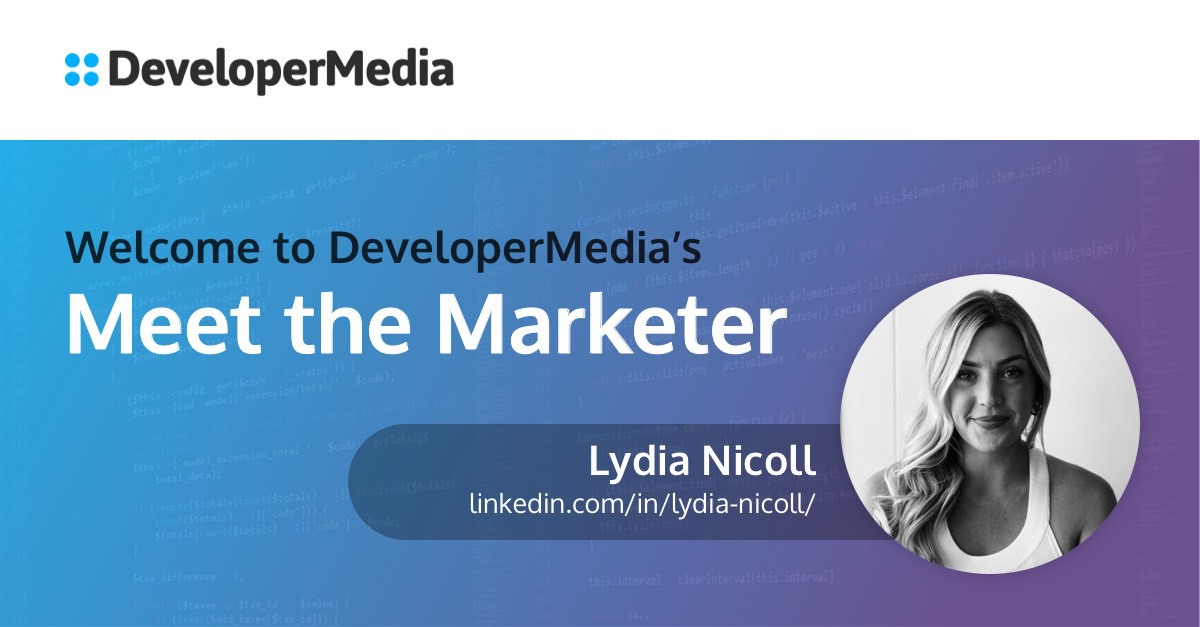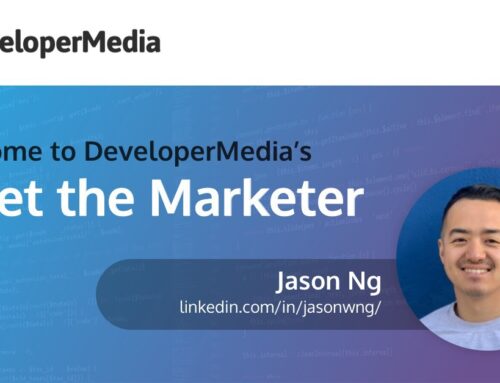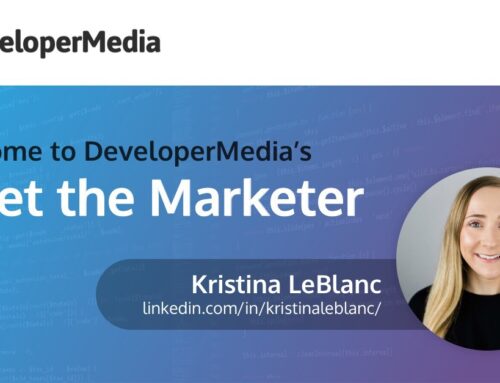Developer Marketing Insights
With this new series, we are spotlighting professionals who are focused on marketing to developers. Our goal with this series is to provide access and insight from peers like Lydia Nicoll, so that you can learn firsthand how they market to developers. We also want to share best practices, and we hope you’ll learn something new!
An American in Paris Malmo
We spoke with Lydia Nicoll, the Chief Marketing Officer at Weavy — a company which offers developers a unique SDK and API solution for in-app collaboration. A graduate of Northeastern University in Boston, Nicoll has resided in Malmo, Sweden for over five years. As part of her responsibilities at Weavy, Nicoll oversees the company’s total marketing strategy.
Says Nicoll: “We are focused on inbound marketing, creating the best possible kind of website experiences, generating leads, and creating all kinds of optimizations for the customer journey. [We also work to ensure] delivery of timely, relevant content, and that our sales team is getting leads.”
Her team is small, with a content and growth automation manager, a performance marketing manager, and subcontractors, such as graphic designers and translators. They focus on timely content delivery, regular website updates, and managing their strategic partnerships, like their partnership with DeveloperMedia. They also use paid advertising and SEO. Primarily, Nicoll ensures everything is getting done on time and that it meets Weavy’s standards.
We asked Nicoll a few questions designed to highlight developer marketing best practices. Our conversation is presented below, edited for length and clarity.
What do you love about developer marketing?
It’s kind of a funny love-hate relationship. I think developer marketing is definitely more challenging than other types of marketing I’ve done before, simply for the fact that I think the typical marketing sweet talk doesn’t really work so well on them. I find that we have to really let our technology do the talking. The proof is in the pudding, as they say. We have to be really knowledgeable and very transparent. And I think that we are held to a higher standard, which is challenging, but also really enjoyable. I think it’s a very honest type of marketing.
What are your greatest challenges?
Our greatest challenge is certainly reaching the right kind of developers. There are so many different frameworks and languages, it’s a challenge making sure that not only are we out there getting in front of developers, but the right ones. We have to articulate the flexibility of our product, and all the great things that you can do with it. It’s a challenge just [to ensure] that we are building enough credibility and trust to get that first chance.
I think when it comes to developers, especially, you really have to impress them the first go- around, or you can potentially lose them forever. So, we spend a lot of time on building our brand awareness and credibility, and also ensuring that we’re providing the best experiences, whether that’s our tutorials, or video demonstrations — or, being at the right events to just get in front of the right audiences and prove credibility. I would say that’s the top priority all the time.
Developers don’t like to feel pushed or sold to, so we let our product speak for itself, but as a company, we have to come across as knowledgeable, professional, and credible.
What surprises you about the developer community?
The thing that first kind of surprised me when I started developer marketing was just how particular developers can be about the technology they use, and what they like. This poses a greater challenge for us as marketers, but it’s also something I respect a lot. It’s a protectiveness they have over the things that they like to use in their languages and how they are developing products. There’s a lot of pride, especially when it comes to building apps and SaaS products, which is our target audience. That was a bit surprising to me, but something I really learned to understand and respect.
Who is your target audience?
We have a lot of different use cases, but the best use case for Weavy is implementing collaboration features into business-to-business SaaS environments, so that end users can collaborate right within an app. Chat is a highly sought-after function, so of course, we get B2C IT customer support use cases, but we’re a lot more than that — activity feeds, contextual threaded conversations, and document collaboration. Weavy is a true collaboration tool. It will help increase product engagement, and boost product stickiness for app developers, and that kind of thing.
We’re built on .NET MVC, so we primarily target Windows users, as well as Azure. Using a server other than Azure takes a little bit more of a white glove approach from our team, but it is something that we offer, and we’re happy to do it. We are currently migrating to .NET core, so there will be a lot more flexibility in the future.
How long have you been marketing to developers?
Primarily, my career has been in B2B (Business-to-Business) SaaS (Software-as-a-Service) marketing. In the past, I’ve been working to target decision-makers such as product managers, CTOs and CEOs. So this is kind of new for me in some ways. I’ve been marketing to developers in the last two years.
What changes have you seen over the past two years?
From the standpoint of our technology, and with COVID and everyone working from home, there has been a huge surge in the need for collaboration features. Big players, like Salesforce that’s acquired Slack, [have done this]. Google just rolled out their new Workplace, with more collaborative features right in their web app. We’re seeing a shift in the market for demand for [products that align with] what we’re doing. And I think that it’s affecting the dynamic between buy versus build.
There are a lot of developers who take pride in the things that they build. And you will always have some developers who don’t want to use a third-party SDK or API solution. But I think because of the speed at which the market is changing, if you want to be ahead of the curve, and if you want to be competitive in the marketplace, you really need to implement these types of features quickly. I think we’re seeing more developers becoming attuned to things like open source and using APIs and third parties rather than developing in-house because they see how quickly you can deploy a really nice feature set without having to spend as much time and resources on building it out yourself.
What’s the next big thing?
It’s exciting [that] offices are starting to open again. I think hybrid work is definitely here to stay, and I think there will be an increasing need for collaborative environments in our apps.
We’re still in an educational phase, where not too many people understand what our value is, in terms of deploying collaboration features into your app. So, we’re building awareness for our in-app collaboration because it might not be something they’re even looking for — maybe they don’t know it exists in the capacity that it does.
As the market matures, and this becomes more commonplace, big players like Salesforce, Google, and even HubSpot are rolling out some collaboration features within the HubSpot platform. At some point we’ll shift our approach from general awareness to educating [people on] why we are the best choice for in-app collaboration as they become aware that it’s something that they want and need. Now we need to show that we’re the best one to go with.
How do you track your marketing campaigns?
We are full-stack HubSpot users. Our entire website. We use the CMS, the CRM, marketing automation, sales tools, and customer service, and we use Hotjar, Google Analytics, and other standard things.
What developer marketing best practices have you developed?
In terms of developer marketing, specifically, authenticity is the best practice. I’m really focused on the product itself, and creating the most enticing environments for developers to actually test our product. We’re using a lot of things like code pens on our site — actual code snippets that they can test out themselves with a lot of interactive content and tutorials where they can build things using Weavy technology for free. We believe that they need to try it and see for themselves. And that’s really all that we can do — let our product speak for itself.
I would say being transparent and authentic when it comes to the developer community is the number one thing. And then, in terms of overall marketing strategy, I would say my best practice is just to segment as much as possible. Don’t try to do too much, but understand you have to segment your audience. And segment your customer journey. You have to define top-level, mid-level and bottom-of-the-funnel experiences and how you can move those customers through the journey while being authentic, helpful, informative, and trustworthy.
Do you miss travelling?
Definitely! I’ve been working remotely for six years, and one of the benefits is that I [usually] travel a lot and work from different places, including all the conferences and events. Travel is definitely something I’m missing a lot. We’re very eager to do some in-person events when restrictions ease, because I think getting in front of the right people and having those personal conversations and learning about what people are interested in is really the best approach in general. We’re excited to do some user group meetups to really support the developer community as well.
What things do you wish you could have in your tool suite to enable you to do your job better?
In terms of technology, HubSpot is pretty comprehensive, so at the moment, I think we’re pretty well covered in terms of tools. I think the one thing that I would love to have is a CRM manager or data analyst on our team because we want to do a bit more in terms of data-driven marketing. Proving marketing ROI, and ensuring that the marketing-to-sales bridge is really solid. As we increase in volume for traffic and inbound leads, it’s important to make sure that your data hygiene is up to snuff. [You need to make sure] that you’re doing the right things and tracking performance, and making sure that your persona profiles are accurate and you’re getting the right information from the sales team funneled back to marketing. That would be the highest on my wish list..
Any notable blunders?
No, I feel really fortunate that the team I have around me are super skilled, very capable. Anything that is a slip-up, we tend to recover pretty quickly, and everything’s a learning opportunity. There’s nothing that’s happened that’s been detrimental or life- altering for us. We’re in a phase of trying to achieve high growth, so we take the mentality of test and iterate. So there are no mistakes, just learning opportunities.
What is your favorite flavor of ice cream?
Ben and Jerry’s vegan mint chocolate chip. Which, funnily enough, you cannot find in Sweden, since they don’t really have mint chocolate chip here. It’s an American thing, and I miss that a lot. Swedish people love licorice-flavored ice cream, but I have not acquired a taste for it.
What do you like about working with DeveloperMedia?
We have a new relationship with DeveloperMedia, but we hadn’t put a lot of budget towards media buys before, so this is something kind of new to us. But it’s been a really great experience so far. They’ve been really supportive, and they definitely feel like they are in our corner and really want us to succeed. The thing that I like the most is that they are ensuring that we’re getting our message in front of the right people, which, as I mentioned previously, can be one of the challenges of marketing to developers. So, I feel like we’re in good hands with them. Our main rep, Meagan, is very responsive, very easy to work with. I really feel she cares about us as a customer. Overall, it’s been a good experience.
Final thoughts?
I really want to emphasize that, at Weavy, [one of the things] we are doing really well is running a really collaborative organization. It wouldn’t be possible without every single person that contributes, and I’m really proud of the team that I have. But more than that, our developers themselves, like our product team, step up and really help support us with technical content. The CEO gets in there and helps with some of our video tutorials, [etc.] and working at events. It’s really a full-on organization effort for the things that we’re doing. I think that’s why we’re succeeding in the developer community — because we’re not just a bunch of marketers trying to talk to tech people. We’re a really tech-forward organization that’s trying to reach people just like ourselves.
Wrap-up
It’s clear from our conversation with Lydia that she is a Weavy evangelist and devoted to serving the developer community. As you read through the interview, you can find best practices, some marketing insights, and evidence of the devotion that Lydia puts into her marketing efforts. Some key elements that contribute to her success and Weavy’s success in developer marketing include:
- Using a robust CRM as the centerpiece of marketing activities. You can’t improve what you can’t measure. A CRM with marketing automation and other tools may seem expensive, but compared to the cost of tracking things manually (or not tracking at all), the right management, automation, and tracking tools are a bargain.
- Understanding the developer audience. Weavy focuses their marketing on the technical content that developers are looking for, and strives to communicate information about their offering honestly, with authenticity and transparency.
- Having an organization which supports your marketing efforts from the top down. Everyone at Weavy who has expertise to help marketing communicate with their audience pitches in, from the CEO down.
Marketing is a rewarding profession and a great career choice, and marketing to developers offers the opportunity to engage with an audience which is genuine and has a sense of community not found in other audiences. If you want to learn more about marketing to the developer community, and the capabilities of DeveloperMedia as a partner, start with the D2D Advertising Guide.
Resources
Weavy – https://www.weavy.com/
DeveloperMedia – https://developermedia.com/
Malmo, Sweden – https://visitsweden.com/where-to-go/southern-sweden/malmo/
HubSpot – https://www.hubspot.com
DeveloperMedia advertising guide – https://developermedia.com/d2d-marketing-an-advertising-guide/



